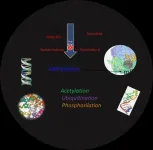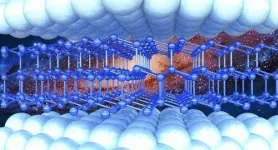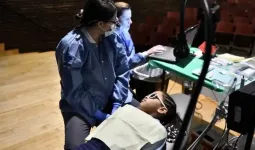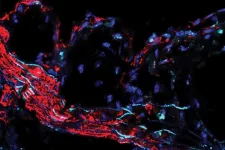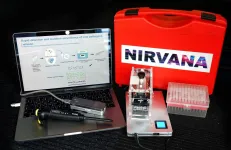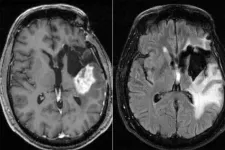(Press-News.org) A team of University of Colorado School of Medicine researchers recently published a paper offering new insight into the role that oxygen deprivation, or hypoxia, plays in cancer development. CU Cancer Center member Joaquin Espinosa, PhD, is the senior researcher on the paper, which he hopes will help lead to more targeted treatments for cancer.
For their paper published this month in the journal Nature Communications, Espinosa and the rest of the team -- Zdenek Andrysik, PhD; Heather Bender, PhD; and Matthew Galbraith, PhD -- used state-of-the-art genomics technologies to map the response of cancer cells to hypoxia with unprecedented detail, leading to novel discoveries about how hypoxia-inducible factors (HIFs) affect cancer cells and tumor growth.
The great hypoxia debate
The cellular adaptation to hypoxia is one of the fundamental aspects of cancer biology, especially in solid tumors.
"Most tumors cannot growth unless they figure out a way to induce formation of new blood vessels to supply them with oxygen and other nutrients," Galbraith explains. "So, what happens inside of solid tumors is they undergo intermittent periods of low oxygen between rounds of new blood vessel formation."
Past research has primarily focused on the long-term effect of hypoxia on tumor growth, generally characterizing it as oncogenic, or cancer promoting. However, other studies indicated that the factors that sense hypoxia, known as hypoxia inducible factors, or HIFs, can act as suppressors of tumor growth in some settings. In order to advance the field beyond this controversy, Espinosa and colleagues investigated the immediate acute response to hypoxia.
"We employed a cutting-edge genomics technology that nobody had employed in this field before that allowed us to see what happens to cancer cells within minutes of depriving them of oxygen," Espinosa says.
This technology enabled them to identify hundreds of hypoxia-inducible genes activated shortly upon oxygen deprivation, the 'first responders' in this important cellular response. Then, they employed computational biology approaches on large, publicly available datasets to infer the function of these hypoxia-inducible genes on hundreds of cancer cell lines grown in the lab and hundreds of tumor samples from cancer patients.
What they found was that when a cell is deprived of oxygen, its first reaction is to stop growing in order to preserve its existing nutrients and oxygen. That means at this point, hypoxia causes a tumor-suppressive reaction, mostly by preventing synthesis of new proteins. It is only after longer periods of hypoxia that tumors start to grow and metastasize as the cells invade neighboring tissues in search of oxygen.
"There's been a lot of debate about whether these hypoxia-inducible factors promote tumor growth or prevent tumor growth," Espinosa says. "The conclusion we came to is that everyone was right to a degree. Hypoxia-inducible factors can suppress tumor growth by preventing protein synthesis early on, but they can also advance tumor growth at later stages by promoting the ability of cancer cells to invade neighboring tissues. It depends on when you're looking at it."
Importantly, the mechanisms of tumor suppression and promotion elicited by HIFs are amenable to pharmacological intervention. Tumor suppression is mediated by inhibition of an enzyme known as mTOR, which in turn can be inhibited by available drugs often used in cancer therapies. "mTOR inhibitors could mimic the tumor suppressive effects of HIFs," Galbraith explains.
The mechanism of tumor promotion, on the other hand, has to do with the cells' need for oxygen after an extended period of hypoxia. Usually, our cells are held together and in place by a structure called the extracellular matrix. However, after being deprived of oxygen for a longer amount of time, the HIFs switch on a set of enzymes that can degrade the extracellular matrix, allowing the cancer cells to escape the oxygen-deprived tumor. This results in the cancer cells entering the bloodstream and spreading to previously healthy tissues.
"These results emphasize the importance of developing inhibitors of hypoxia-inducible enzymes that degrade collagen and other components of the extracellular matrix," Espinosa says.
A new map offers hope for targeted treatments
Espinosa and his team hope that their research will guide the development of future therapies that can better target not only cancer cells themselves, but also target the right processes in cancer cells at the right times. Whereas our previous understanding may have led cancer researchers to try to shut down the hypoxia response altogether, the CU team's research indicates that it may be preferable to target it only at certain times.
"People have been trying to target the hypoxia-inducible factors with different therapeutics, but this research would suggest that you may want to exercise some caution about when you apply those therapeutics, given that the HIFs can be tumor suppressive in the early stages of hypoxia," Galbraith says.
"Since the hypoxic response can be tumor suppressive in some contexts and oncogenic in other contexts, it's not a good idea to issue a blanket statement that we should always try to shut it down," Espinosa adds. "Instead, we should be thinking about what aspect of the hypoxic response to target, and that's the aspect where hypoxia drives invasion and metastasis."
The research is also groundbreaking in its detailed mapping of the hypoxic response in cancer cells, which Espinosa says was only possible using new technologies.
"How do you make new discoveries?" Espinosa asks. "Well, you use new technologies and new instruments, and that's where the Cancer Center is always very supportive, making sure that the Shared Resources have the latest instruments."
Espinosa expects to see follow-up studies from researchers using the map his team has created in the future.
"I would say this is a definitive improvement in the mapping of the early events of hypoxia," Espinosa says. "And the beauty of that is that once you have a good map of the land, a lot of people can use it."
INFORMATION:
Abusive alcohol drinking considerably impacts human health. Alcoholism, better defined as Alcohol Use Disorders (AUD), includes a group of pathological entities related to alcohol-induced damage. Individuals with AUD exhibit compulsive alcohol drinking and negative emotional states when alcohol drinking ceases. In the most severe AUD forms, the individuals lose control over consumption despite a decided will to stop. Some controversial issues have arisen as to whether the definition of AUD can help to delimit and characterize clinical entities related to abusive alcohol ingestion.
The World Health Organization (WHO) reports that approximately 3,3 million people (5,9% of global ...
New findings from a Michigan Medicine study reveal that antibody testing is predictive of prior COVID-19 infection, and rapid screening methods - even from finger pricks - are effective testing tools.
Researchers analyzed antibody tests conducted on more than 500 subjects in patient care settings. They found that people who had COVID, including those with mild symptoms, produced antibodies.
"For a long time, people were very worried that people with mild COVID did not make immune responses," says Charles Schuler, M.D., a clinical assistant professor of allergy and immunology at Michigan Medicine. "This should give people confidence that the tests that are available to them aren't just random number generators. They're actually giving them ...
New "sweat stickers" may streamline the early diagnosis of cystic fibrosis by enabling scientists to easily gather and analyze sweat from the skin of infants and children. The stickers matched the performance of previous, more cumbersome devices when tested with 51 subjects, suggesting the stickers could address design obstacles that have held back the diagnosis and treatment of cystic fibrosis in pediatric patients. Diagnosing cystic fibrosis in infancy or childhood is critical to achieve good outcomes, as current treatments must be given early to extend lifespans and alter the course of the disease. Many current diagnostics work by detecting levels of chloride in sweat, which are elevated in cystic fibrosis patients. However, these tests must often be repeated and use unwieldy wrist-wrapped ...
For many parents, the COVID-19 pandemic has made life's everyday juggling act--managing work, school, extracurricular, and household responsibilities--much, much harder. And according to a new study led by Penn sociologists, those extra burdens have fallen disproportionately on mothers.
The research, shared in the April issue of the journal Gender and Society, investigated how shifts in work and school that arose due to the pandemic triggered changes in the division of labor in families. Using data on two-parent households from a nationwide survey conducted in April 2020, the researchers found that ...
Scientists from the Skoltech Center for Energy Science and Technology (CEST) have developed a method for modeling the behavior of 2D materials under pressure. The research will help create pressure sensors based on silicene or other 2D materials. The paper was published in the ACS Nano journal.
Silicene, which is regarded as the silicon analog of graphene, is a two-dimensional allotrope of silicon. In its normal state, bulk silicon is a semiconductor with a diamond crystal type structure. As it thins down to one or several layers, its properties change dramatically. However, it has not yet been possible to study the change in the electronic properties of 2D materials at high pressure.
Scientists from Russia, Italy, the United ...
In a longitudinal study published earlier this month in the Journal of the American Dental Association, researchers analyzed untreated decay in a cohort of nearly 7,000 children enrolled in the ForsythKids preventive dentistry program. Over the course of six years, the percentage of children with untreated cavities in the program decreased from 39 to 19 percent, suggesting that school-based prevention programs are effective in combating childhood dental disease.
Tooth decay is the most common chronic early childhood disease in the United States. More than half of children aged 6-8 years old have had a cavity, and kids from low-income families ...
High cholesterol is the most commonly understood cause of atherosclerosis, a hardening of the arteries that raises the risk of heart attack and stroke. But now, scientists at Washington University School of Medicine in St. Louis have identified a gene that likely plays a causal role in coronary artery disease independent of cholesterol levels. The gene also likely has roles in related cardiovascular diseases, including high blood pressure and diabetes.
The study appears March 24 in the journal Science Translational Medicine.
Studying mice and genetic data from people, the researchers found ...
LA JOLLA--(March 31, 2021) Clinicians using a new viral screening test can not only diagnose COVID-19 in a matter of minutes with a portable, pocket-sized machine, but can also simultaneously test for other viruses--like influenza--that might be mistaken for the coronavirus. At the same time, they can sequence the virus, providing valuable information on the spread of COVID-19 mutations and variants. The new test, dubbed NIRVANA, was described online today by a multi-institution team of scientists in the journal Med.
"This is a virus detection and surveillance method that doesn't require an expensive infrastructure like other approaches," says Juan Carlos Izpisua Belmonte, co-corresponding author and a professor in Salk's Gene Expression ...
AURORA, Colo. (March 31, 2021) - A new study published in Frontiers in Psychiatry finds that patients with Obsessive Compulsive Disorder (OCD) as well as other psychiatric comorbidities, such as autism spectrum or tic disorders, may respond well to Deep Brain Stimulation (DBS).
DBS is a minimally invasive neurosurgical procedure that uses coordinates to target certain areas of the brain, implanting electrodes that can help regulate abnormal brain activity. DBS procedures are rare for OCD in the United States; only a couple hundred patients have received this treatment for OCD management since its FDA approval ...
An aggressive type of brain cancer, glioblastoma has no cure. Patients survive an average of 15 months after diagnosis, with fewer than 10% of patients surviving longer than five years. While researchers are investigating potential new therapies via ongoing clinical trials, a new study from Washington University in St. Louis suggests that a minor adjustment to the current standard treatment -- giving chemotherapy in the morning rather than the evening -- could add a few months to patients' survival.
The study appears online in the journal Neuro-Oncology Advances.
Average overall survival ...

